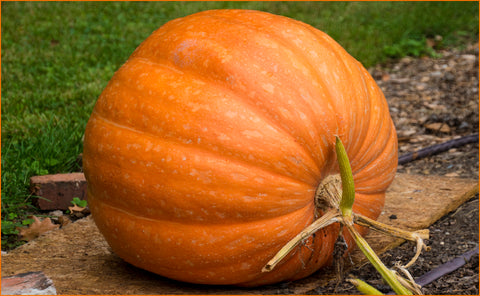What would the month of October be like without the presence of pumpkins? We cannot imagine an autumn in New York without these orange icons appearing at every roadside farm stand, or piled high at every city’s corner deli.
In honor of Eleanor Roosevelt’s 129th birthday tomorrow, NYSOM would like to take you back to Val-Kill, Mrs. Roosevelt’s estate in the Hudson Valley, to meet some gourds of grandeur. Eleanor’s retreat, office and home, where she engineered many ideas for political and social change (and met with Khrushchev and John F. Kennedy, among others) from about 1924 until her death in 1962, all resided at Val-Kill, part of the Roosevelt-Vanderbilt National Historic Sites. But this fall, coinciding with the end of the growing season, there have been some enormous additions to the property: these giant pumpkins.

Photo: "Pumpkin -- Garden at Val-Kill..." by Ron Cogswell is licensed under CC BY 2.0
The idea for the giant pumpkin patch was initiated by the Roosevelt-Vanderbilt National Historic Site horticulturalist, Anna deCordova, who learned much about and from Mrs. Roosevelt through the process of landscaping Val-Kill. Ms. deCordova conserves the property and landscape, which celebrates and cultivates the spirit of Eleanor. Other projects have included the rebuilding of a cutting garden — raised beds within a hedge where Eleanor would have grown flowers for the purpose of being cut and gifted to others or used to decorate her home.The primary mission of the landscaping projects at Val-Kill, according to Ms. deCordova, is to “in every way we can, promote the treatment philosophy, which is to restore a sense of active use.” Ms. deCordova, who leads volunteers in various projects every Wednesday, admires Eleanor as a “great example of perseverance.” Instead of justifying why something cannot be done, she is inspired to become involved in a small and meaningful way, and make a difference thereon. “We have that philosophy with all of our projects, particularly at Val-Kill, with our volunteers who come because they admire Eleanor,” says Ms. deCordova. “I love that that admiration led them to take this step toward contributing to making her home the only national historic site dedicated to a First Lady, to making it special, and bringing it to a level that’s worthy of the legacy that she left us. We do that by starting small, taking manageable bites, avoiding that sense of being overwhelmed. It all starts with being simple and logical. That’s how she approached everything.”
It was this perseverance, in addition to the determination to hold fast to tradition and a sense of utility that led Anna to the idea for a giant pumpkin patch. Not to mention, Eleanor also loved Halloween. Last winter, Anna wanted a new project that would engage her weekly volunteers, but also hold fast to the original goals of Val-Kill. So, they decided to grow some very large pumpkins. This unique activity would not only fulfill the treatment philosophy of Val-Kill, but also give the visiting public a sense of use with a crop that was new to the property.
Uri Perrin, executive director of the Honoring Eleanor Roosevelt organization, which works to conserve and preserve Val-Kill, praises the pumpkin patch at Val-Kill as “a wonderful way for visitors to connect with Eleanor's love of traditions and the informal festivities that she made a hallmark of gatherings at Val-Kill, the place Eleanor loved most." Efforts like the restoration of her gardens “offer authentic windows to rediscover and appreciate anew this woman whose influence is still so widely felt." Though access to Eleanor’s house is led exclusively by park ranges, the landscapes on the property are all self-guided, encouraging guests to look around at their own pace.
There are four different kinds of pumpkins in the patch, but one variety trumps all. That seed, selected by Ms. deCordova in Nova Scotia, is Dill’s Atlantic Giant the genetics of which have led these pumpkins to their larger-than-lifesize grandeur. While the seeds are not originally from New York, the seeds that will be harvested from these pumpkins after cross-pollination (which they’ll save for potential use next year) will be from New York. The pumpkins probably won’t be edible because the flesh will be so tough, but they will be displayed at Val-Kill throughout the month of October, encouraging visitors to explore the outdoor landscape at Val-Kill. After all, Val-Kill’s main original purpose was to escape to the outdoors.
This is Anna’s third year at Val-Kill. Prior to joining the Vanderbilt Roosevelt National Historic Site, she was the horticulturalist at Locust Grove, Samuel Morse historic site in Poughkeepsie. She loves the public outreach and volunteer aspect of working at a historic garden site, and how she must “think about what a landscape is in the context of its history. It’s an interesting exercise.” There is certainly no typical day for Anna at the site, she consistently decreases maintenance, and improves appearance. (Another project she recently led is the Gardens of Hope, Peace & Justice, which is in its second year with Girl Scouts working toward their journey award. The troops study their food footprint, human rights issues, looking at the garden through the lens of Eleanor Roosevelt, justice and their food footprint being their underlying drive).
It’s too soon to say if they’ll grow the pumpkins every year, but they’ll discuss during the deep winter when things aren’t growing. The property’s treatment also states that all of the flowers must look fantastic for Eleanor’s birthday. Head up to Val-Kill this month to see these great pumpkins tomorrow, or in the coming weeks to see what’s left of the season. They may even carve one of the gourds closer to Halloween. We like to think that Linus would find greatness in them too.

Leave a comment